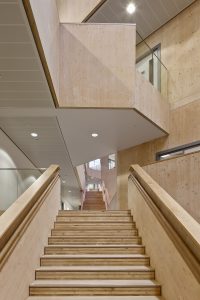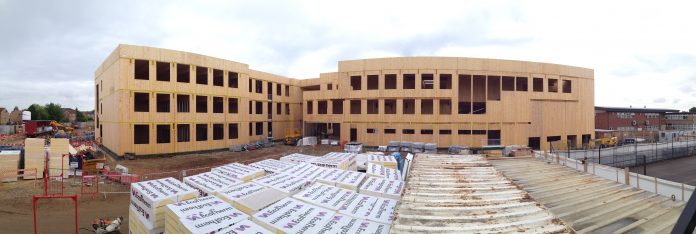Structural timber technology is seriously reducing carbon emissions and the sector is witnessing unprecedented demand for sustainable advanced offsite manufactured solutions. Andrew Carpenter from the Structural Timber Association discusses the benefits of engineered timber solutions
We define engineered timber or solid wood, as it is also known, as heavy structural timber elements made up by bonding timber lamellas together to form units with known structural characteristics.
There are two main structural solutions – cross laminated timber (CLT), formed by gluing lamellas into a wide and long panel, and glued laminated timber (GLT), formed by gluing lamellas on top of each other to form a beam. Here we explore the benefits of cross laminated timber.
Cross laminated timber
Cross laminated timber is a structural two-way spanning timber panel that can be used to form walls, roof and floor panels, as well as shear walls. Cross laminated timber panels are available in Spruce, Douglas Fir and Larch and can be supplied as FSC® and PEFC certified.
It is produced by laminating and finger jointing soft wood timber lamellas at 90° to the layer below. This can encompass between three and seven layers. The structural benefits of cross laminated include its large bi-axial and flexural loadbearing capacity when used as a wall or slab, together with its superior acoustic and performance properties. Cross laminated timber is five times lighter than concrete and also distributes concentrated loads as line loads at foundation level, which reduces the requirement for localised pad foundations.
In addition to excellent sustainability credentials, good thermal insulation performance and sound insulation properties – it is speed of construction where cross laminated timber is in a class of its own. Cross laminated timber, as a rapid, robust and reliable offsite manufactured solution, delivers many benefits during the construction process and beyond. From reducing loading on foundations through to impressive thermal, acoustic and airtightness performance – cross laminated timber construction enhances projects across all sectors.
Being manufactured to exceptional levels of accuracy in factory-controlled conditions ensures minimal defects and improves construction and project delivery time, reducing costs and maximising efficiency on all levels – providing cost and programme certainty.
However, the benefits do not end after the construction phase. Due to the enhanced performance values and robust nature of cross laminated timber, the ongoing lifecycle costs of the building is vastly reduced through less maintenance requirements and lower energy consumption.
Benefits to construction processes 
Using cross laminated timber for prefabricated wall and floor panels offers many advantages including:
- Prefabrication results in rapid construction for reliable onsite programming.
- Improved dimensional stability allows for prefabrication of long and wide panels.
- Panels are inherently robust during transport and construction, resulting in fewer defects.
- Panels can be assembled with lightweight power tools and require fewer onsite mechanical fixings.
- Cladding materials/services can be fixed directly to panels with no requirement for wet trades.
- Creates relatively low levels of onsite noise, disruption and waste.
- CLT buildings have a very low carbon footprint and can achieve carbon-negative construction.
Developed to meet the high requirements of modern timber construction, cross laminated timber optimises the structural values of timber by taking advantage of its exceptional aesthetic and load-bearing characteristics whilst enhancing its structural performance, creating highly sustainable and healthy environments.
The time is right for the construction industry to embrace innovative timber technology and offsite techniques, supported by design for manufacture and assembly protocols, to develop better buildings at a rapid rate to enhance lives, minimise the environmental impact and reduce energy costs for building owners and occupiers for many years to come.
About the Structural Timber Association
As offsite timber solutions are gaining traction across the industry, the STA’s mission is to enhance quality and drive product innovation through technical guidance and research, underpinned by a members’ quality standard assessment – STA Assure. This scheme offers reassurances to the construction community that members meet or even exceed current legislation and regulatory requirements. By exploiting advanced offsite manufacturing technology to increase capacity, structural timber systems are factory produced to exacting standards for onsite installation, improving resource efficiency – delivering exceptional quality and minimal defects.
For more information on the Structural Timber Association and to access the technical library go to: www.structuraltimber.co.uk
Andrew Carpenter
Chief executive
Structural Timber Association
Tel: +44 (0)1259 272140














